Yotam Ottolenghi baking recipes: Use berries in abundance
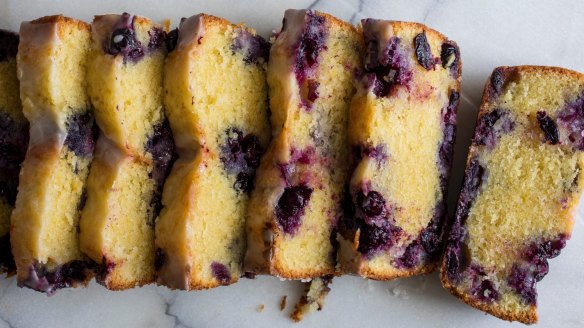
My relationship with berries follows the same arc as so many relationships: ignorance, discovery, infatuation, growth, complacency and, then, happy coexistence.
Stage 1 – blissful ignorance – sees me growing up thinking that raspberries came in a bottle of an overly sweet cordial that you'd dilute with water and drink after school. It was called mitz pettel (raspberry juice) and had never seen a fresh raspberry in its life.
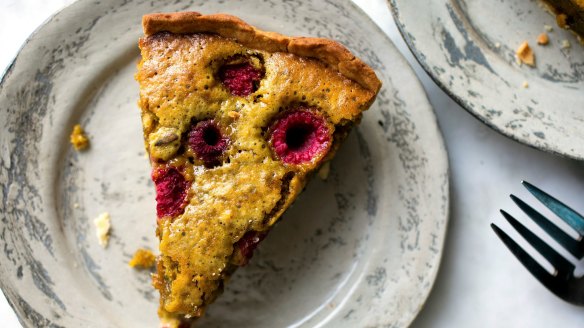
Mine was by no means a fruit-deprived childhood. I grew up in Israel, surrounded by an abundance of the tree-grown sorts: fresh figs, pomegranates, lemons and dates. Apart from a glut of late-winter strawberries, though, fresh forest berries – the small fruits, like raspberries, blackberries and blueberries, born on bushes and low plants – were just not around. The hot Middle Eastern climate didn't allow it.
Stages 2 and 3 – discovery and infatuation – hit me hard during what I rather grandly called the 'European Tour'. The reality was delightfully ungrand: It was 1986 and my best schoolmate and I landed in West Germany, bought two old bikes and proceeded to cycle through the Netherlands and Belgium, to Paris.
It took us a month and, along the way, I fell in love with berries. Coming from a land of tree-borne fruit, I couldn't get enough of the delicious reality of low-lying bushes and plants offering up more fresh berries than I could possibly consume. Our paths were paved with gold, our fingers stained with purple and I was (metaphorically, thank goodness, given my position on the bike) head over heels.
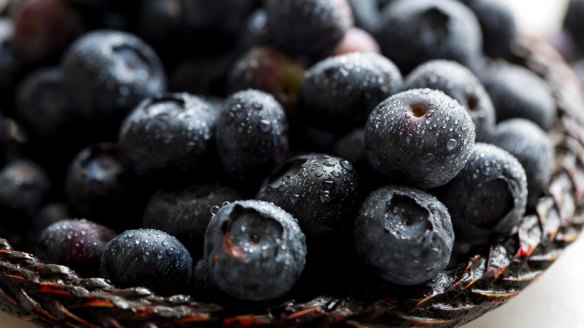
Stage 4 was growth and learning, when I was working in my first professional kitchen at Launceston Place in London, under the tutelage of the chef Rowley Leigh. He was showing me how to make a summer pudding, and just as he had inverted the berry-filled and wine-soaked bread onto a platter to serve, he inverted everything I had thought about berries until then. For me, they were to be treated with a degree of reverence and restraint; I'd grown up seeing them placed, individually, on top of the rare gateau in a few cafes in Tel Aviv, Israel.
Here, however, Rowley was doing with berries what Middle Eastern cooks do with herbs: using them in absolute abundance. They were not things you would use to garnish or finish off a dish. They were the very building blocks of the dish itself.
Once I fully understood the brilliant power of giving berries the leading role in a dessert, I just rolled along with it. In fact, I possibly went a bit overboard, creating my own berry-filled, berry-topped, berry-dotted, berry-coated, berry-everything set of puddings: white chocolate mousse with crushed frozen berries inspired by Stars restaurant in San Francisco; baked cheesecake with a light biscuit base like the ones I had growing up, now swirled through with a thick blackberry coulis; pies and turnovers stuffed to the brim with stone fruits or apples, alongside blackberries, raspberries or blueberries; and countless ice-creams, parfaits, sorbets and semifreddos, all delightfully cold, sharply sweet and berry bright.
By the time I mastered berries, I also knew I wanted to become a pastry chef, so I got a job at a London chain of patisseries, Maison Blanc. Alas, rather than learning the fine art of French cake making as I thought I would, I found myself on a production line throwing raspberries onto individual creme patissiere-filled tarts. Within a very short time, my love affair with berries had entered the post-honeymoon phase: complacency. This was not what the catalogue had promised at all. Complacency did not feel right, though, so I hopped off that particular conveyor belt and moved forward.
The years that followed had a moderating effect. They brought with them a slightly more measured, less intoxicated approach. When I set up my own shop window at Ottolenghi in Notting Hill, raspberry-swirled meringues soon became part of our signature look, alongside many other fruity delights.
My relationship with berries has since kept on moving toward that happy stage of balanced coexistence. The berries are still there, of course, used in all sorts of ways in all sorts of dishes: blitzed to make a puree for icing or buttercream; kept whole in a batter, as with the blueberry cake (see recipe below), or slightly crushed so the juices start to bleed; hiding inside a roulade, waiting to be revealed; or sitting royally as they do in this pistachio tart.
The figs, dates, lemons and pomegranates are just as much there as well, splashing their colour through all that I bake, the fruits of my childhood and the fruits of my first trip away from home. It feels as if the arc has come full circle and I'm allowed the best of all worlds.
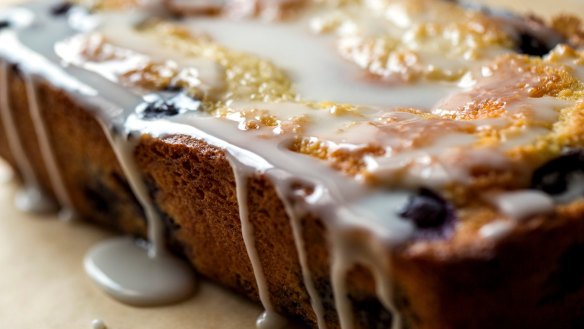
Blueberry, almond and lemon cake
Ingredients
150g unsalted butter, at room temperature, plus extra for greasing the pan
1 scant cup (190g) castor sugar
1 tsp lemon zest, plus 3 tsp lemon juice (or more juice as needed)
1 tsp vanilla extract or essence
3 large eggs, beaten
⅔ cup (90g) plain flour, sifted
1¼ tsp baking powder
⅛ tsp salt
1 cup (110g) almond meal
1½ cups (200g) fresh blueberries
⅔ cup (70g) icing sugar
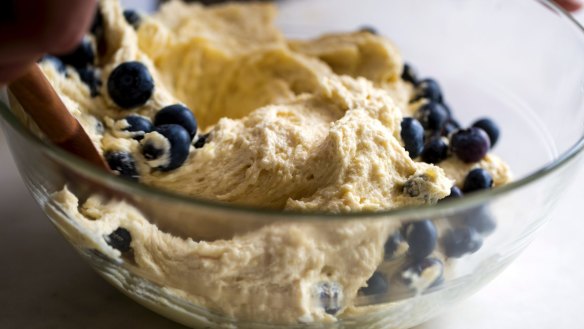
Method
1. Heat oven to 200C. Grease a 21-centimetre loaf tin with butter, line it with a baking paper sling and butter the paper. Set the tin aside.
2. Place butter, sugar, lemon zest and vanilla extract in the bowl of a stand mixer fitted with the paddle attachment. Beat on high speed for three to four minutes, until light, then lower speed to medium. Add eggs in three additions, scraping down the sides of the bowl a few times as necessary. The mix may split a little but don't worry: It'll come back together once you add the dry ingredients.
3. In a separate bowl, whisk together flour, baking powder, salt and almond meal. With the stand mixer on low, add the dry ingredients in three additions, mixing just until no white specks remain. Fold in about three quarters of the blueberries by hand, then scoop batter into the prepared loaf tin.
4. Bake for 15 minutes, then sprinkle the remaining blueberries over the top of the cake. Return to the oven for another 15 to 20 minutes, until cake is golden brown but still uncooked. Cover loosely with foil and continue to cook for another 25 to 30 minutes, or until risen and cooked, and a knife inserted into the middle of the cake comes out clean. Remove from oven and set aside in its tin to cool for 10 minutes before removing cake from tin and placing on a wire rack to cool completely.
5. When cake is cool, make the icing: Add lemon juice and icing sugar to a bowl and whisk together until smooth, adding a bit more juice if necessary, just until the icing moves when you tilt the bowl. Pour over the cake and gently spread out. The blueberries on the top of the cake may bleed into the icing a little, but this will add to the look. Let icing set (about 30 minutes), slice and serve.
Serves 8
An earlier version of this recipe stated the incorrect quantity for butter. This has since been updated
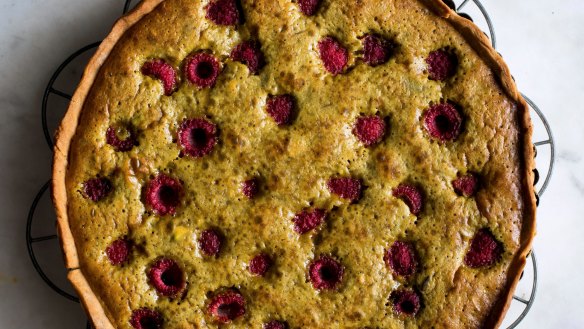
Pistachio and raspberry tart
Ingredients
For the pastry
150g plain flour, more as needed
1 tbsp(20g) castor sugar
¼ tsp salt
1 tsp finely grated lemon zest
80g cold unsalted butter, cut into 2-centimetre pieces
¼ tsp white wine vinegar
1½ to 2tbsp ice water
For the pistachio filling
2½ cups (350g) raw, shelled pistachios
3tbsp (60g) unsalted butter, melted
1 tsp lemon zest, plus 3tsp lemon juice
1 tsp vanilla extract or essence
⅛ tsp almond extract or essence
⅛ tsp salt
3 large eggs
⅔ cup (150g) castor sugar
3 tsp (15g) plain flour
1 heaped cup (150g) fresh raspberries
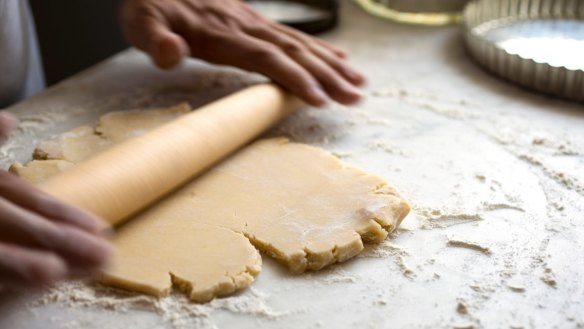
Method
1. Make the pastry: Place flour, sugar, salt, lemon zest and butter in a food processor and blitz for about 15 seconds, until it reaches the consistency of fine breadcrumbs. With the machine running, add vinegar and then add water slowly, half a tablespoon at a time, until mixture comes together (you may not need all the water). Form dough into a ball, wrap with plastic wrap and refrigerate for at least 30 minutes.
2. On a lightly floured work surface, roll out dough to form a circle about 33 centimetres wide and 2 millimetres thick. Carefully transfer the dough (wrap it around a rolling pin, if that helps you) to a 26-centimetre round fluted tart tin with 3-centimetre-high sides. Press the dough securely into the corners of the pan and trim the crust 1/2 centimetre above the rim of the tin, then refrigerate for 30 minutes.
3. Heat oven to 200C.
4. Line the dough with a large piece of baking parchment and fill the tart with dried beans or pie weights. Bake for 25 minutes, or until pastry is golden brown around the edges. Remove beans and paper and continue to bake the pastry for eight minutes until the base is golden brown. Remove from oven and set aside.
5. Lower oven temperature to 170C.
6. Make the filling: Spread pistachios out on a baking sheet and roast for eight minutes, until they are hot but haven't taken on any colour. Remove from oven and carefully transfer three-quarters of a cup (100g) of nuts to a cutting board and set aside. Immediately blitz remaining nuts in a food processor while they are still hot. Keep the machine going for six to eight minutes, scraping down the sides of the bowl a few times when the nuts stop moving, until you get a thick smooth paste and the nuts begin to ball up in the bowl. Add melted butter, lemon zest, juice, vanilla extract, almond extract and salt and pulse a few times until combined. Roughly chop the reserved pistachios.
7. Place eggs in the bowl of a stand mixer fitted with the whisk attachment. Whisk on high speed for three to four minutes, until soft peaks form. Reduce speed to medium and slowly add the sugar until incorporated. Add flour, pistachio paste and chopped pistachios and mix on low until combined. (You may need to scrape the pistachio paste off the bottom of the bowl.) Pour the mixture into the tart shell, spreading it out evenly. Sprinkle raspberries over the filling and bake for about 35 minutes, until golden brown around the edges, pale golden in the centre and set.
8. Remove from oven and let cool completely in the tin. Once cool, the tart can be lifted out of the tin and transferred to a platter to slice and serve. The filling should be soft, but still hold its shape when sliced.
©The New York Times
Appears in these collections
The best recipes from Australia's leading chefs straight to your inbox.
Sign up